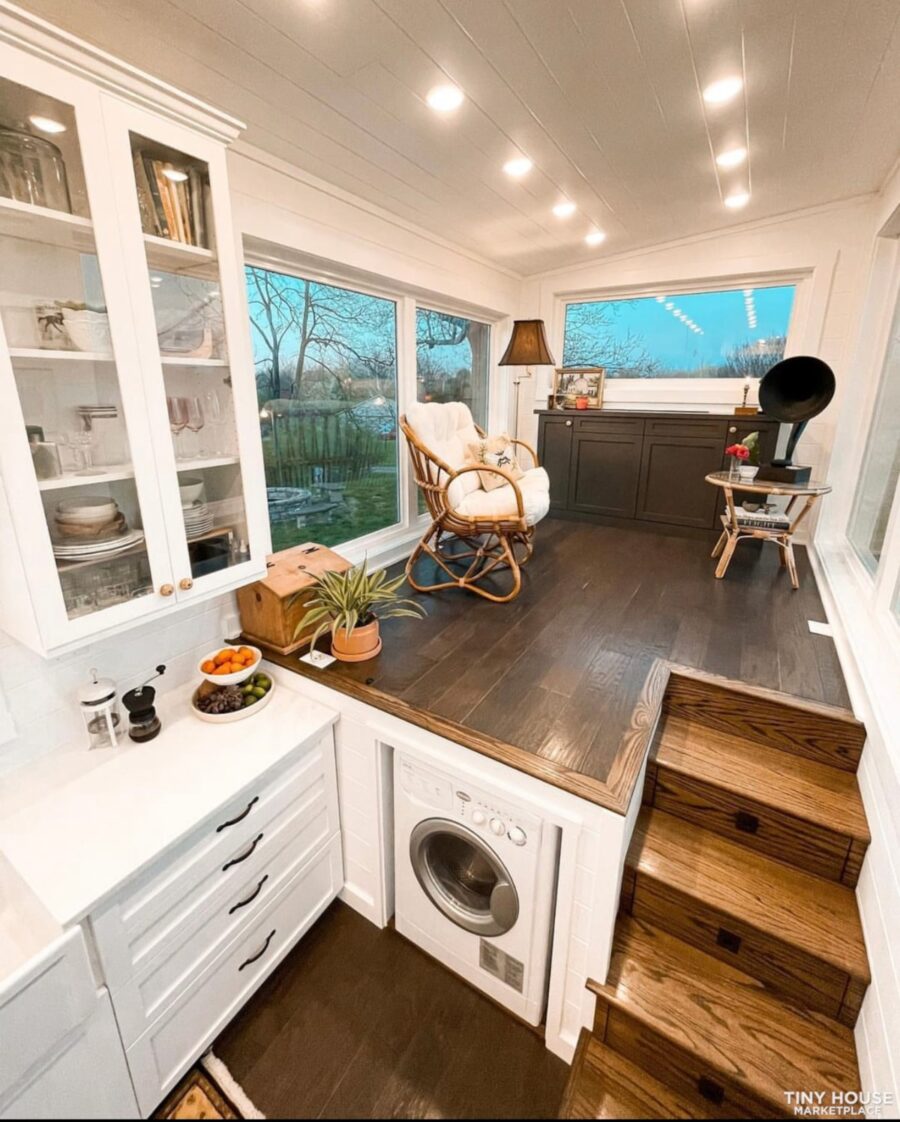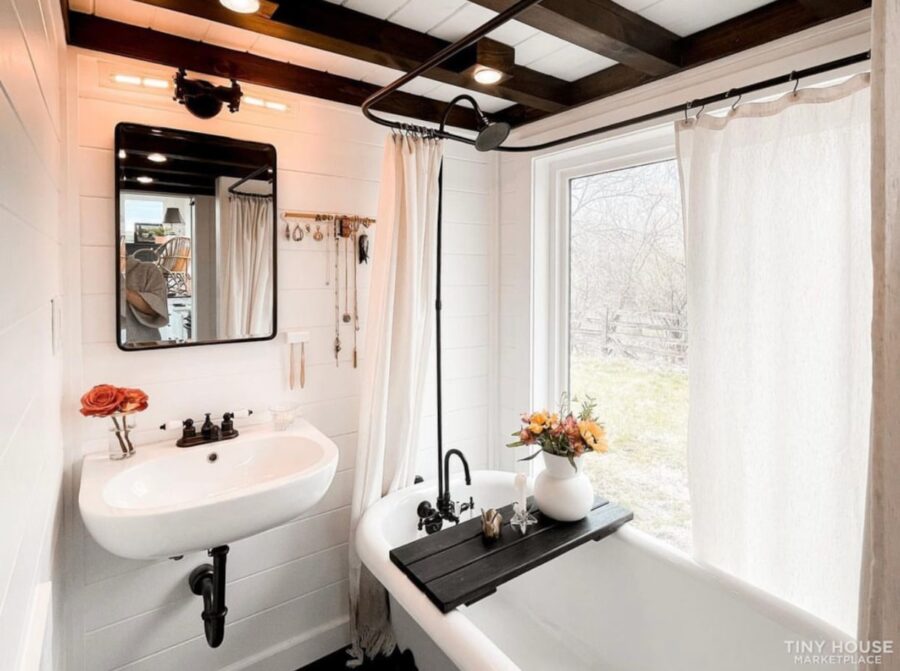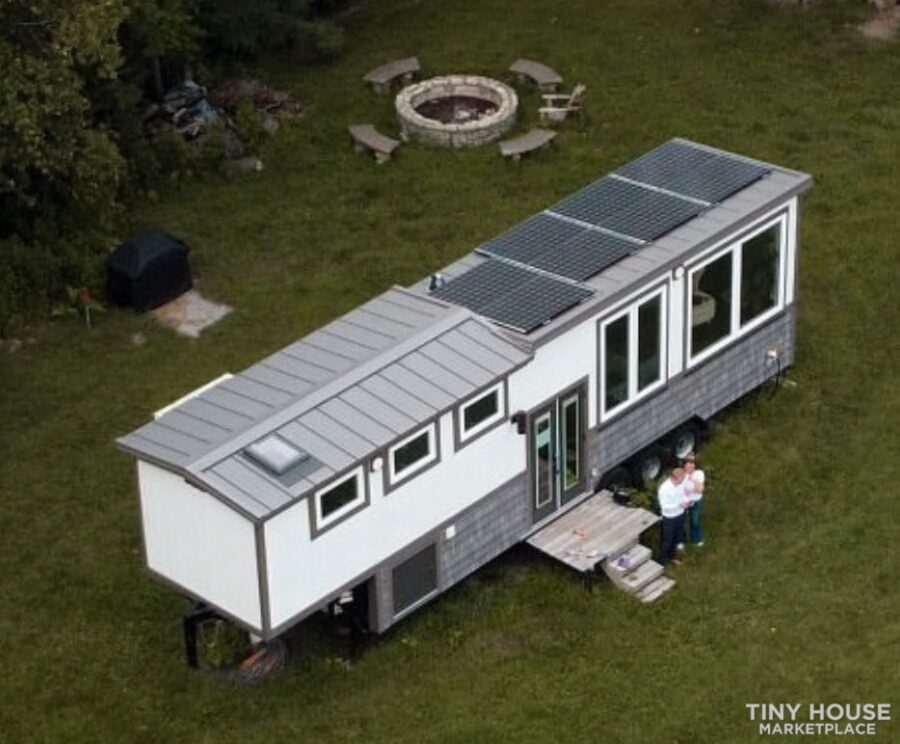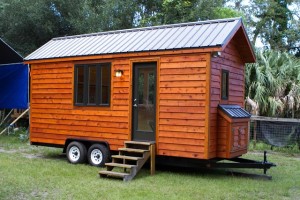This post contains affiliate links.
This gorgeous off-grid-capable gooseneck tiny house is 40 feet long and includes a beautiful bathroom with a clawfoot tub and a separate little area for the composting toilet. The home is RVIA and NOAH-certified, giving you peace of mind.
The main area of the home is a long galley kitchen bursting with storage. There’s a standing room in the loft bedroom, as well as a living room over the gooseneck. It’s for sale in Glenwood Springs, Colorado for $290K.
Don’t miss other interesting tiny homes like this one – join our FREE Tiny House Newsletter
NOAH-Certified Fifth Wheel Tiny Home in Colorado For Sale

Images via Tiny House Marketplace
Looking down to the gooseneck living room.

Images via Tiny House Marketplace
I would probably put a little couch up here!

Images via Tiny House Marketplace
The kitchen has a nice RV oven and tons of storage.

Images via Tiny House Marketplace
In the bathroom, there’s this gorgeous clawfoot tub with a shower head attachment.

Images via Tiny House Marketplace
The exposed beams are such a nice touch.

Images via Tiny House Marketplace
The window over the sink opens to let in the cool air.

Images via Tiny House Marketplace
It’s off-grid ready and could house a lot of solar on the roof!

Images via Tiny House Marketplace
Details:
- $290K
- Off-grid-capable
- Luxury tiny home
- 330 sq ft 1 bed, 1 bath (40’ X 8.5’ X 14.5’)
- High-ceilings
- Beautiful glass cabinets
- Large windows
- Gas range
- Quartz countertops
- Farmhouse sink
- Gorgeous barn door
- Clawfoot tub
- Individual or couple
- Solar-powered with RVIA and NOAH-certified RV hookups
- Washer/dryer combo
- Wall-mounted heating & air conditioner split unit
- Gyro ceiling fan
- Extra storage drawers in each stair
- 8.5’X6’ storage space accessible from the exterior
Learn more:
Related stories:
- DIY $220K Luxury Sprinter Van for Retirees
- They Built This THOW in Just 7 Days!
- All-Electric e-Boho-XL Tiny House Available Now with a $7.2K Discount
You can share this using the e-mail and social media re-share buttons below. Thanks!
If you enjoyed this you’ll LOVE our Free Daily Tiny House Newsletter with even more!
You can also join our Small House Newsletter!
Also, try our Tiny Houses For Sale Newsletter! Thank you!
More Like This: Tiny Houses | THOWs | Tiny House Builders | Tiny Houses for Sale
See The Latest: Go Back Home to See Our Latest Tiny Houses
This post contains affiliate links.
Natalie C. McKee
Latest posts by Natalie C. McKee (see all)
- 641 sq. ft. Prairie Cottage House Plans - May 1, 2024
- Small Log Cabin in Virginia with Creek For Sale - May 1, 2024
- Serenity Now: Romantic Cabin in Vermont - May 1, 2024






When a fad becomes a growing trend and then a popular lifestyle, the prices are bound to increase but $290,000????? Holy moly!!! That’s $853 a square foot! I will be among the first to say that this is a beautiful Tiny Home but there simply aren’t enough materials to justify that. Yes, the materials are nice but by those financial standards, my 1600 square foot house would be worth almost $1.4 million dollars! Nothing in this house requires a big volume of luxury materials to warrant that price. Or maybe that was a typo? I believe that this is the most expensive Tiny posted by THN and I’m sure at least some of the crew are wondering what the reaction will be. Wonder no more! It’s gorgeous and tasteful but not for that amount of money. It doesn’t even include any land! I’m sorry. I’m not usually flummoxed by these posts but I can’t help but be astonished. Too expensive, even by California standards! Kudos to the designers but whoever is in charge of pricing is way off.
Hey Donna, an understandable reaction. Especially, with the lack of details listings like this often provide.
However, just for future reference, pricing is more complicated than just cost per sq ft. Especially, since cost per sq ft is a misleading way to judge value by itself because it’s only really useful to compare very similar products but any significant differences and it quickly loses any relevance.
Mind, cost per sq ft doesn’t account for build quality or lack thereof, what features are and aren’t included, the amount of labor involved, the amount of craftsmanship it required, whether the home will be toxic or healthy to live in, whether the home meets special needs or is just generic, whether any additional services or details were involved in its creation, etc.
Details like whether it was custom built, involved an architect, and/or engineer, etc. can automatically put it into a completely different price range from most regularly built homes. Along with features like whether or not it can function off grid that are not included in the cost of most regular homes.
Even for regular homes, materials typically account for less than half the total cost. So there’s a lot more to it than just the material costs. Add, most of the cost relates to providing functionality and tiny homes simply pack more functionality into a smaller space than larger homes. So it should also be understood that cost per sq ft doesn’t scale linearly, either, as another reason why using cost per sq ft can be misleading without proper context and details…
Besides, in the world of high end homes it can actually exceed $2000 per sq ft. There are 1600 Sq Ft homes worth millions. There’s even custom built luxury high end RV’s that are worth upwards to over $3 million on the really high end. All before accounting for how high costs have gotten in the last 2 years with the present economy and driven the prices of everything up and understanding that virtually nothing has been spared this trend.
So, when looking at products like this, things to consider are whether or not it was custom built, whether or not it involved additional services like an architect, designer, engineer, etc. Along with details like being able to use the home off-grid, possible hidden details like an ERV, etc. that add functionality that regular homes don’t have, whether the home was all hand made or uses off-the-shelf products, the present state of the economy, the location, etc. Since all those details can significantly change the costs and thus what to realistically expect the price to be for it…
For example, both RVIA and NOAH certifications have to be paid for, this has both, and thus that’s an additional cost. While not mentioned, the home does have either an HRV or ERV. Along with other details, which just lack specifics, like the solar power system and the statement that it’s off-grid capable that indicates there’s more included than the listing specifies.
A home like this will typically require everything to be custom hand made, which significantly increases the labor cost before even adding services like custom building, architect, designer, engineer, etc.
Just an architect, for a regular built home, can account for up to 10% of the total budget cost, more if it’s a really well known or even famous architect. Along with other things that can add to the total costs. Like even for regular homes, furniture can add 10%-50% to the cost of the home… Then add the cost of a designer, etc…
Needless to say, there’s a lot that can effect the price and I haven’t even listed them all…
That said, all of that is just to provide context to understand where prices like this can come from and that it isn’t always based on just the market but the actual costs involved. It just doesn’t mean you can’t still be incredulous at the price because it can be done cheaper, as long as you’re willing to accept the trade offs and compromises it can be done for a lot cheaper. The original owner of this just wasn’t willing to do that and now has to deal with the consequences for how that effects its resale-ability, a general con for custom builds, but that’s their problem and not yours…
I agree with Donna, way too expensive. I read your reply, what about A warranty? How long is this tiny home projected to last?
How are they serviced do you service these tiny homes personally? Thank you
Warranty depends on the builder and products they use in the construction of the home. From the builder, the warranty is typically limited to the original owner but the products used in the construction may have their own warranty. Like a metal roof may have warranty from the manufacturer of the roof system. Otherwise, like regular houses, it’s advised to have some form of insurance coverage.
Note, resale sites like Tiny House Marketplace are 3rd party and the seller may be a previous owner instead of from the builder. Articles like this are just to provide information and aren’t representing anyone. So, unless someone states they are the seller or builder then it’s usually safe to assume the comment is just from another fellow commentator…
While actual tiny houses are still houses and thus would last for approximately a similar length of time for an equivalently built traditional house, assuming similar environment, amount of maintenance, level of craftsmanship, materials, etc.
There can be more wear and tear if it’s moved regularly and different climates may significantly effect its longevity. However, tiny houses are generally not intended to be moved often and ideally it’s more optimal to keep a structure in a stable environment that it was built to handle.
Consequently, there can be additional costs related to constructing a structure that can adapt and handle multiple climates and weather conditions. Including additional equipment like advance air-exchangers that help reduce the loss or gain of energy between the interior and exterior as air is exchanged. A ERV, Energy Recovery Ventilation, for example helps with both heat and humidity. While a HRV, Heat Recovery Ventilation, only helps with heat… Among many other things that can be part of the total costs that aren’t part of every house build.
Such details can be significant to the costs, but also either overkill or minimum requirement depending on where the home will be located.
For service, aside from warranty and insurance coverage, it’s similar to regular houses and you can even DIY, if that’s an option for you.
RVIA certification is only for RV’s and thus only states that the product meets the standards for vehicle road safety standards. While NOAH is technically similar but was created as a certification option specific for tiny houses and thus goes a little beyond RVIA and clarifies whether the structure can meet the standards of a residential home. There are places that can take such certification to allow it to be placed on a property and classified as a residential home but that is still pretty rare for most of the country.
A growing number of states are adapting Appendix Q, which was introduced with the 2018 IRC update, pretty much all building codes in the states are based on this albeit not everyone updates to the latest version right away, to add tiny houses to the building codes. So, there’s starting to be places where you can place the structure on a foundation and show it meets Appendix Q to then have it treated like a regular residential property and get a certificate of occupancy.
While, there are still many places that will only treat anything on wheels as an RV, this is just to point out that there is actually a real difference and how the construction of tiny houses should be viewed is mostly equivalent to a traditional structure, it’s just placed on a wheeled platform instead of a foundation. Thus answering your question on how long it should last…
So they can last decades or longer, unless you abuse and trash it. It’s just something to keep in mind anything can be built from very simple and minimal standards to very advance and extreme standards. Like a house that may last only a few decades before it needs to be demolished and replaced to a multi-generational home that may last 500+ years.
There can be a big difference from one house to the next but that’s why there are standards, certifications, building codes, inspections, etc. but like shopping for anything, it still helps to understand the details and what you are and aren’t paying for to properly assess the true value of the property and what details actually effect the final total costs and whether or not that matters to you or decide to avoid it to look for another option…